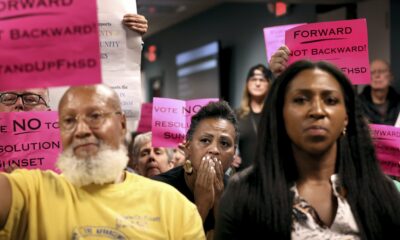Labor & Economy
50 Candles: The March on Washington

August 28 of this year marks the 50th anniversary of the famous March on Washington. For many people, the march was simply the site where Dr. Martin Luther King delivered his “I Have a Dream” speech. However, the full name of the march was the March on Washington for Jobs and Freedom, and it marked a high point of the modern Civil Rights Movement, after black communities and their supporters throughout the country boycotted buses, sat-in at lunch counters, rode in Freedom Rides, and marched in the streets. These massive protests were aimed at destroying, once and for all, the era of legal segregation — which had been a blot on this country since the end of slavery.
But organizers knew that the end of segregation without good jobs was no freedom at all. So, four of the march’s ten demands focused on employment issues. (See the ten demands and other items in the march’s “Organizing Manual No. 2” here, and hear Bayard Rustin read off the demands and A. Philip Randolph leading the march’s pledge here.)
What is not widely known is the key role [of] labor unions in getting people to DC. Cleveland Robinson, leader of the Retail, Wholesale and Department Stores Employees Union’s District 65, was in charge of the Administration Committee — and his union provided three trains and 18 buses. The International Ladies’ Garment Workers Union charted 16 trains and 15 buses. Timuel Black, an activist in the Chicago teachers union, got two trains and an airplane to send marchers from Chicago. The United Auto Workers brought 5,000 people to the march.
Historian Will Jones documents these details in his upcoming book, The March on Washington: Jobs, Freedom, and the Forgotten History of Civil Rights. (See his article on the topic here.) Jones also uncovers the role of black unionists in the origins of the march. In 1960, A. Philip Randolph and others formed the Negro American Labor Council to push for the rights of black workers in the labor market and the union movement. Upset with the lack of progress, the group began to make plans for a march in Washington DC to pressure Congress to act. As these plans were advancing, other black leaders urged black unionists to join the march planned by civil rights activists from the South. Hence, the Southern-based March for Freedom became a March for Jobs and Freedom.
As a result of the March on Washington and other organizing efforts throughout the country, Congress passed many of the laws that officially ended legal segregation. These victories were not just victories for the black community. As progressive black leaders and union leaders had known, the same forces that oppose civil rights oppose worker rights. [Which is why], in 1946, the CIO started “Operation: Dixie” with the dual goal of organizing black and white workers in the South and building the political muscle to defeat the Dixiecrat politicians who voted against civil rights and worker rights. In 1958, the NAACP [National Association for the Advancement of Colored People] in California joined forces with the California Labor Federation to defeat Proposition 18 which attempted to turn the state into a “right-to-work” state. In their opposition to the measure, the NAACP passed out literature saying, “Keep Mississippi out of California.”
This year, as we commemorate the 50th anniversary of the March on Washington for Jobs and Freedom, we must recognize that, despite our immense progress, we still live in a time when black voting rights are challenged, immigrants are being denied basic human rights and workers and their unions are under attack. We need to learn that key lesson from the March on Washington — jobs and freedom go together.
(Dr. Steven Pitts has served as Labor Policy Specialist at the UC Berkeley Labor Center since 2001. His post first appeared on Labor’s Edge and is republished with permission.)
-

 California UncoveredApril 9, 2024
California UncoveredApril 9, 2024700,000 Undocumented Californians Recently Became Eligible for Medi-Cal. Many May Be Afraid to Sign Up.
-

 Feet to the FireApril 22, 2024
Feet to the FireApril 22, 2024Regional U.S. Banks Sharply Expand Lending to Oil and Gas Projects
-

 Class WarMarch 26, 2024
Class WarMarch 26, 2024‘They Don’t Want to Teach Black History’
-

 Latest NewsApril 10, 2024
Latest NewsApril 10, 2024The Transatlantic Battle to Stop Methane Gas Exports From South Texas
-

 Latest NewsApril 23, 2024
Latest NewsApril 23, 2024A Whole-Person Approach to Combating Homelessness
-

 Latest NewsMarch 27, 2024
Latest NewsMarch 27, 2024Street Artists Say Graffiti on Abandoned L.A. High-Rises Is Disruptive, Divisive Art
-

 State of InequalityApril 11, 2024
State of InequalityApril 11, 2024Dispelling the Stereotypes About California’s Low-Wage Workers
-

 Latest NewsApril 24, 2024
Latest NewsApril 24, 2024An Author Reflects on the Effort to Rebuild L.A. After the ‘Violent Spring’ of 1992




















